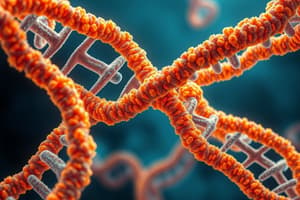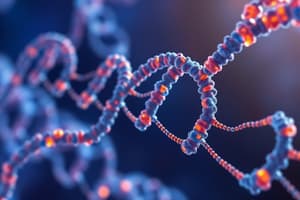Podcast
Questions and Answers
Chromosomes are composed of chromatin, which consists of DNA and associated proteins like histones.
Chromosomes are composed of chromatin, which consists of DNA and associated proteins like histones.
True (A)
The diploid number of chromosomes in human somatic cells is 48.
The diploid number of chromosomes in human somatic cells is 48.
False (B)
Histone proteins that form the core of chromatin include H1, H2A, H2B, H3, and H4.
Histone proteins that form the core of chromatin include H1, H2A, H2B, H3, and H4.
False (B)
During interphase, chromosomes are visible as distinct structures.
During interphase, chromosomes are visible as distinct structures.
Cohesion and CTCF are important for the formation of loop domains in chromatin.
Cohesion and CTCF are important for the formation of loop domains in chromatin.
The amount of DNA in a species is directly proportional to its complexity or intelligence.
The amount of DNA in a species is directly proportional to its complexity or intelligence.
Cell cycle duration is consistent across all cell types, averaging around 24 hours.
Cell cycle duration is consistent across all cell types, averaging around 24 hours.
Gorillas have a somatic cell chromosome count of 80.
Gorillas have a somatic cell chromosome count of 80.
Cells spend the majority of their life in interphase, which consists of two metabolically active phases, G1 and G2.
Cells spend the majority of their life in interphase, which consists of two metabolically active phases, G1 and G2.
Mitosis results in producing three daughter nuclei containing identical sets of chromosomes as their parent cell.
Mitosis results in producing three daughter nuclei containing identical sets of chromosomes as their parent cell.
The phases of mitosis include prophase, prometaphase, metaphase, anaphase, and telophase.
The phases of mitosis include prophase, prometaphase, metaphase, anaphase, and telophase.
During prometaphase, chromosomes begin to lose their structure and lose attachment to the spindle microtubules.
During prometaphase, chromosomes begin to lose their structure and lose attachment to the spindle microtubules.
Chromosomes line up at the equator of the cell during anaphase.
Chromosomes line up at the equator of the cell during anaphase.
In interphase, DNA is duplicated only if the cell is prepared for division.
In interphase, DNA is duplicated only if the cell is prepared for division.
During telophase, chromosomes are grouped at the poles and decondense.
During telophase, chromosomes are grouped at the poles and decondense.
Sister chromatids separate at their centromeres during metaphase.
Sister chromatids separate at their centromeres during metaphase.
Flashcards are hidden until you start studying
Study Notes
Eukaryotic Chromosomes
- Chromosomes are made of chromatin, a material consisting of DNA and proteins called histones.
- Histones are highly conserved proteins, indicating their crucial role in nuclear biology.
- Core histones (H2A, H2B, H3, H4) form an octamer around which DNA wraps.
- H1 histone, a linker histone, helps package nucleosomes.
- Chromatin fibers further compact into loop domains facilitated by CTCF and cohesin.
- Chromosomes exist in an extended, partially unraveled form during interphase.
- During cell division, chromatin condenses, making chromosomes visible.
- Condensin complexes contribute to chromosome condensation during mitosis and meiosis.
Chromosomes and Species
- Each species has a unique chromosome number in its somatic cells.
- Human somatic cells have a diploid number (2n) of chromosomes, meaning two sets of 23 chromosomes, one from each parent.
- The total number of chromosomes in humans is 46.
- The number of chromosomes and DNA amount don't correlate with complexity or intelligence of a species.
Cell Cycle
- The cell cycle is an ordered sequence of events where a cell duplicates its contents (interphase) and divides into two (M phase).
- The number of cell divisions in a cell lineage is defined.
- The timing of the cell cycle varies widely between actively growing cells.
- Cells spend most of their time in interphase, but the duration varies between cell types.
- Interphase has two gap phases (G1 and G2) which allow cells to grow, synthesize materials, and monitor their environment before committing to S and M phases.
Mitosis
- A nuclear division mechanism occurring in somatic cells.
- Produces two identical daughter nuclei with the same chromosome sets as the parent.
- Divided into five phases: prophase, prometaphase, metaphase, anaphase, and telophase.
Phases of Mitosis
- Interphase: The cell carries out its usual activities. DNA replication occurs if the cell is preparing to divide.
- Prophase: Long chromatin condenses into mitotic chromosomes, each consisting of two sister chromatids attached at the centromere. The mitotic spindle forms between centrioles and moves to opposite poles. The nuclear envelope breaks down.
- Prometaphase: Spindle microtubules attach to kinetochores on the centromeres, pulling chromosomes toward the cell's midplane.
- Metaphase: Chromosomes align at the equator of the cell. Spindle microtubules attach each chromosome to both poles.
- Anaphase: Sister chromatids separate at their centromeres, moving to opposite poles.
- Telophase: Chromosomes cluster at the poles, decondense. Nuclear envelope reforms, creating two separate nuclei.
Mitosis Summary
- Mitosis is a precise process that ensures each daughter cell receives a complete set of chromosomes from the parent cell.
- It is essential for growth, development, and repair in multicellular organisms.
Studying That Suits You
Use AI to generate personalized quizzes and flashcards to suit your learning preferences.




